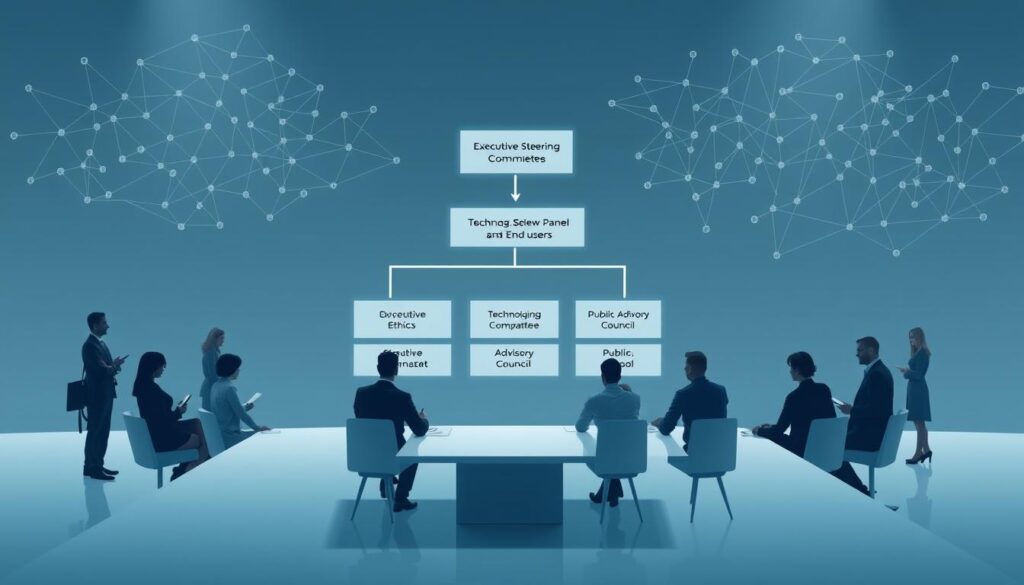Can organizations truly balance rapid technological advancement with societal accountability? This critical question lies at the heart of modern discussions about machine learning governance. As advanced systems reshape industries, specialized committees emerge to address the complex relationship between innovation and responsibility.
These governance groups operate as strategic advisors, helping companies align technical projects with core values. Their formation often responds to growing public demand for responsible development practices and regulatory requirements. By evaluating potential risks and benefits, they create frameworks that protect both organizational interests and community welfare.
Effective oversight requires diverse expertise. Members typically combine technical knowledge with legal, philosophical, and social science perspectives. This multidisciplinary approach ensures decisions account for varied impacts across user groups and ecosystems.
Key Takeaways
- Specialized committees guide ethical implementation of advanced technologies
- Cross-functional teams bridge technical development and social responsibility
- Proactive governance helps navigate evolving regulatory landscapes
- Transparent decision-making processes build stakeholder trust
- Balancing innovation with ethical constraints drives sustainable progress
Role and Responsibilities of AI Ethics Boards

Without structured oversight, innovation risks outpacing societal safeguards. Specialized governance committees address this gap by creating frameworks that align technical projects with human values. Their work spans from policy creation to real-time system evaluations, ensuring ethical principles guide every development phase.
Navigating Complex Dilemmas
These committees employ systematic strategies to identify and resolve moral conflicts. One approach involves mapping potential consequences across different user groups through scenario analysis. As noted by a Stanford researcher, “Effective governance requires anticipating outcomes beyond immediate technical success.”
Key processes include:
| Process | Objective | Outcome |
|---|---|---|
| Risk Profiling | Identify bias sources | Mitigation plans |
| System Audits | Verify compliance | Transparency reports |
| Stakeholder Forums | Gather diverse input | Updated protocols |
Creating Actionable Standards
Governance groups convert abstract ideals into practical checklists for development teams. For autonomous systems, this might involve testing protocols for edge-case scenarios. Continuous monitoring mechanisms track deployed systems against predefined benchmarks, allowing rapid response to emerging issues.
Three core focus areas guide these efforts:
- Privacy preservation in data handling
- Fairness verification across user demographics
- Documentation standards for audit trails
Building Trust Through Transparency and Accountability

Transparent operations form the cornerstone of stakeholder trust in tech governance. Specialized committees strengthen credibility through measurable actions that demonstrate alignment between organizational goals and societal expectations. Public reporting mechanisms enable stakeholders to verify compliance with declared principles across development cycles.
Strategies for Public Engagement
Governance groups maintain open channels for community input through town halls and digital platforms. One financial institution’s recent webinar series showcased how technical teams incorporate public feedback into algorithmic design. This approach transforms complex technical processes into understandable narratives through visual dashboards and plain-language summaries.
Regular system audits create tangible evidence of accountability. Independent reviewers assess decision-making patterns against predefined fairness benchmarks. Their published findings help organizations identify improvement areas while demonstrating commitment to ethical practices.
Ensuring Independent Oversight
Structural safeguards prevent conflicts of interest in governance processes. External experts comprising 40% of review panels bring fresh perspectives to internal discussions. “True accountability requires separation between operational teams and evaluation bodies,” notes a Harvard governance researcher.
Three-tier verification systems ensure rigor:
- Technical validation of system outputs
- Legal compliance checks
- Social impact assessments
These layered evaluations create multiple accountability checkpoints. Grievance mechanisms allow citizens to challenge automated decisions through formal appeals processes. Such frameworks turn abstract principles into concrete trust-building measures.
Integrating Ethical Considerations in AI Development and Deployment

The path from concept to real-world application demands more than technical expertise. Organizations now implement structured protocols to address moral challenges during system creation and implementation phases. These ethical considerations transform theoretical ideals into operational guardrails.
Risk Assessment and Bias Mitigation
Proactive evaluation frameworks identify potential harms before deployment. Amazon’s discontinued recruiting tool exemplifies why systematic risk assessment matters. The system excluded female candidates due to historical hiring patterns in training data. Modern governance teams now mandate:
- Demographic fairness testing across all user groups
- Scenario analysis for edge-case failures
- Third-party audits of decision-making patterns
These practices help prevent discriminatory outcomes while maintaining technical performance. Continuous monitoring systems track deployed solutions, enabling rapid response to emerging issues like Uber’s 2020 autonomous vehicle incident.
Aligning Projects with Societal Values
Tech leaders increasingly prioritize collective welfare over narrow objectives. IBM’s withdrawal from facial recognition sales demonstrates this shift. Development teams now use alignment frameworks that evaluate:
- Long-term social impacts
- Stakeholder value distribution
- Regulatory compliance pathways
Cross-functional collaboration ensures moral evaluation occurs throughout advancements in intelligent systems. Sector-specific guidelines address unique challenges in healthcare, finance, and public safety applications.
Structuring Effective AI Ethics Boards

How companies structure their governance teams determines whether moral guidelines translate into real-world practices. Two primary frameworks exist for oversight bodies: those embedded within organizations and independent third-party groups. Each model presents distinct advantages and operational challenges.
Internal Versus External Models
Embedded teams operate as company divisions, leveraging institutional knowledge for swift decisions. Members familiar with internal processes can align recommendations with strategic goals. However, proximity to leadership may create conflicts when addressing sensitive issues.
| Feature | Internal Model | External Model |
|---|---|---|
| Proximity to Operations | High | Limited |
| Decision Speed | Fast | Moderate |
| Independence | Potential Bias | Enhanced |
| Information Access | Full | Contractual |
Independent groups offer impartial perspectives through separation from corporate hierarchies. A 2023 MIT study found external committees identify 37% more potential risks in early system designs compared to internal teams. Yet, they may lack context about technical constraints or organizational priorities.
Member Selection and Diverse Expertise
Effective governance requires blending technical mastery with social awareness. Selection committees prioritize candidates demonstrating both system design knowledge and ethical reasoning capabilities. One healthcare consortium combines computer scientists with civil rights advocates in their review panel.
| Selection Criteria | Purpose | Outcome |
|---|---|---|
| Technical Proficiency | Evaluate system mechanics | Practical solutions |
| Ethical Training | Assess societal impacts | Balanced decisions |
| Demographic Diversity | Identify bias patterns | Equitable systems |
Rotating membership every 18-24 months introduces fresh perspectives while maintaining institutional memory. Regular performance reviews ensure teams adapt to evolving technical landscapes and societal expectations.
Operational Processes and Decision-Making Best Practices
Effective governance requires structured frameworks for resolving complex questions. Specialized committees implement tiered voting systems to maintain rigor while enabling timely action. These processes balance thorough evaluation with organizational agility, ensuring critical choices withstand scrutiny.
Establishing Voting Procedures and Quorums
Governance groups categorize decisions based on potential impact. Routine operational updates might require 51% approval, while transformative policy changes demand higher thresholds. Three decision tiers guide this approach:
| Decision Type | Voting Threshold | Review Timeline |
|---|---|---|
| Procedural Updates | Simple Majority | Annual |
| Policy Revisions | Two-Thirds Majority | Quarterly |
| System Overhauls | Unanimous Consent | Immediate |
Quorum rules prevent limited participation from skewing outcomes. A financial technology consortium recently demonstrated this by requiring 60% attendance for all votes. “Demographic diversity in decision rooms matters as much as in training data,” notes their governance lead in a published case study.
Documentation practices create accountability trails. Detailed minutes record:
- Alternative proposals considered
- Rationale for final choices
- Dissenting perspectives
Structured discussion formats help members focus on societal impacts rather than technical minutiae. Quarterly review cycles allow adjustments as new information emerges, maintaining alignment with evolving standards.
Resources, Compliance, and Sustaining Responsible AI Practices
Sustaining responsible technological practices requires more than good intentions. Organizations must establish robust support systems that address financial, informational, and regulatory needs. These frameworks ensure continuous alignment between technical initiatives and societal expectations.
Securing Funding and Access to Information
Diversified funding streams protect oversight independence. While companies often provide baseline support, blending philanthropic grants with public funding reduces reliance on single sources. Deutsche Telekom’s approach demonstrates this balance – 35% of their governance budget comes from external partnerships.
Comprehensive data access remains critical for informed decisions. Teams require detailed project reports, compliance documentation, and third-party research. A telecommunications leader recently standardized access protocols across 14 departments, cutting review times by 40%.
Adopting Regulatory and Best Practice Frameworks
Proactive compliance strategies help organizations stay ahead of legal requirements. Many adopt hybrid models combining ISO standards with sector-specific guidelines. These frameworks guide technical teams while allowing flexibility for unique operational needs.
Education programs bridge policy and practice. Mandatory training modules for data science teams translate complex regulations into actionable checklists. Regular updates ensure employees understand evolving requirements – particularly crucial for systems handling sensitive user information.
Continuous monitoring systems track 18 key performance indicators across development cycles. Automated alerts flag potential compliance gaps, enabling swift corrective action. This approach transforms abstract guidelines into measurable operational benchmarks.
Conclusion
As intelligent systems reshape industries, governance bodies prove essential in aligning progress with human values. These committees establish systematic evaluation processes. They assess technical projects against privacy standards and accountability measures throughout development cycles.
Effective oversight extends beyond regulatory compliance. Forward-thinking organizations embed ethical principles into strategic planning, creating cultures where responsible practices drive decision-making. This approach builds trust while addressing complex challenges in system deployment.
Continuous education programs strengthen organizational capacity. Employees gain practical understanding of evolving guidelines, ensuring teams implement safeguards effectively. Diverse expertise – combining technical knowledge with social awareness – remains critical for balanced innovation.
Organizations leveraging advanced AI solutions benefit from structured governance frameworks. Such systems help mitigate risks while maximizing societal benefits. The future demands collaborative models where internal teams, external experts, and policymakers jointly navigate emerging challenges.







